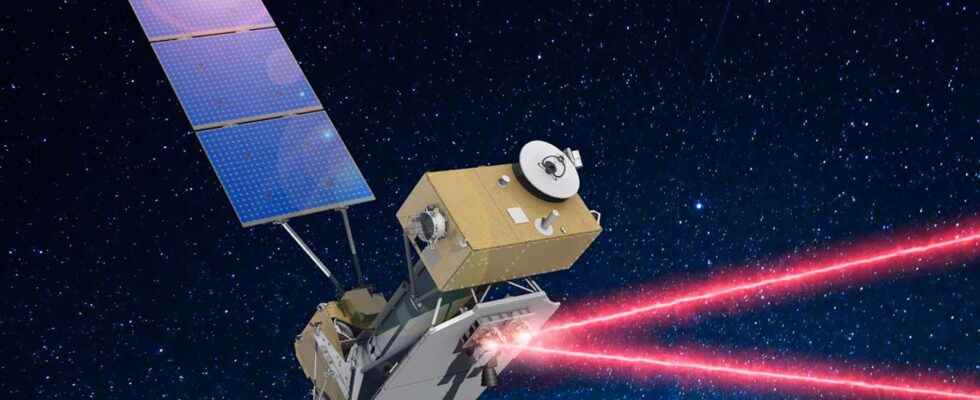NASA is preparing to test and demonstrate from geostationary orbit state-of-the-art laser optics technology to communicate in space. The goal is to succeed in transmitting over very long distances large amounts of data that the radio waves, currently used, have great difficulty in relaying in a short time. This experiment is installed on board the STPSat-6 satellite of the United States space force, which is scheduled to launch on December 5.
You will also be interested
For his next mission with a launcher Atlas V (version 551), ULA will launch two satellites to demonstrate new technologies and risk reduction as part of the US space program Air United States force and space force. The launch is scheduled for December 5 from the launch complex 41 of the space base of Cape Canaveral, in Florida. The two satellites will be placed in a geosynchronous orbit, more than 36,000 kilometers away.
This STP-3 mission provides for the launching of the space vehicle Space Test Program Satellite 6 (STPSat-6) which will carry the experimental nuclear explosion detection system Space and Atmospheric Burst Reporting System-3 (SABRS-3) of the National Nuclear Security Administration as well as the laser communications relay (LCRD) demonstration system of the Nasa. The satellite has an adapter on which secondary payloads are attached.
LCRD is a NASA laser communications relay demonstration system that foreshadows the future of space communications, without actually doing without airwaves. radio which will always be useful. NASA’s technological bet, already won by Europe which has a laser communication operational system around the Earth (EDRS), is to succeed in transmitting large amounts of data over very long distances which could lead to debits multiplied by 10 to 100 times compared to radio links. That said, radio communications will still be used despite their downside due to the fact that they spread rain or snow, unlike the laser which is likely to be blocked by clouds or disturbed by theatmosphere of a planet.
Eliminate transmission delays that make immediate access to satellite data impossible
To understand the interest of such a system, it is necessary to know that today the space missions and the satellites ofEarth observation generate such large volumes of data that frequencies radio have a hard time relaying them to Earth in a very short time. In addition, theecosystem of New Space gave birth to a multitude of new public and commercial services based on the speed of acquisition and use of data from Earth observation. As for probes sent to worlds other than Earth, the technological performance of observation, analysis and study instruments is such that traditional space communication networks are saturated to relay data to Earth.
If Europe is one step ahead with EDRS developed and produced as part of a private public partnership (PPP) set up between ESA and Airbus, NASA’s objective is to acquire a laser communication system capable of exchanging data between Earth, Moon, Mars and the infrastructure orbiting these two planets and our natural satellite.
As you will have understood, LCRD is not an operational system but a technological demonstration. It is expected to be able to transfer data at a rate of 1.2 gigabits per second between LCRD and ground stations located in California and Hawaii. This speed is almost double the transfer rates achieved in 2013 during the LLCD technology demonstration, on board the lunar probe Ladee from NASA, which relayed data from the Moon using an optical signal at 622 megabits per second.
For NASA, it is not only a question of demonstrating that its system is capable of transferring data at such a speed. She also wants to understand how the atmosphere can degrade and disrupt the optical signal. LCRD will also be used as a test bed to lay the foundation for advanced communication techniques. We think of adaptive optics systems future giant telescopes, again protocols standards for the exchange of information so as to replace proprietary protocols, for example.
A laser to communicate between Mars and Earth
Article by Remy Decourt published on 03/04/2005
Mars is a priority objective for NASA as shown by its program of exploration of the planet for the period 2009 and 2020, mainly focused on the issue of life, the return of samples and the development of precursor missions to human exploration. of the planet Mars.
In the next few years, NASA anticipates that many missions (landers, rovers and orbiters) will be operational on Mars at the same time. It therefore wants to equip itself with a new communication system between its missions and Earth different from the traditional radio wave system currently used.
Today, the communication time between a Martian probe and Earth can reach up to 20 minutes. This delay is incompressible, but NASA would like to increase the transmission capacities in order to be better informed. scientific measurements carried out on Mars and its surroundings, but also to obtain precise data on the state of the various spacecraft.
NASA and the Massachusetts Institute of Technology (MIT) are working on a new laser communication system between the two planets capable of transmit at up to 30 million bits per second, which would be as fast as permitted using the optical fiber for example. This system would be 10 times faster than transmission by radio waves.
For this, the demonstrator Mars Laser Communications Demonstration was developed and to be launched in 2009 on the probe Mars Telecommunications Orbiter (MTO). It will operate for at least a year in orbit around Mars and transmit data from active missions. This period will be used by NASA to carry out a whole series of tests and technical validation.
This will mainly involve securing transmissions, measuring signal loss, due to the distance between Mars and Earth, and mastering the technique of beam aiming, an essential condition for receiving the data.
Ultimately, NASA wishes to significantly improve its ability to communicate throughout the Solar system.
Interested in what you just read?
.
fs3
